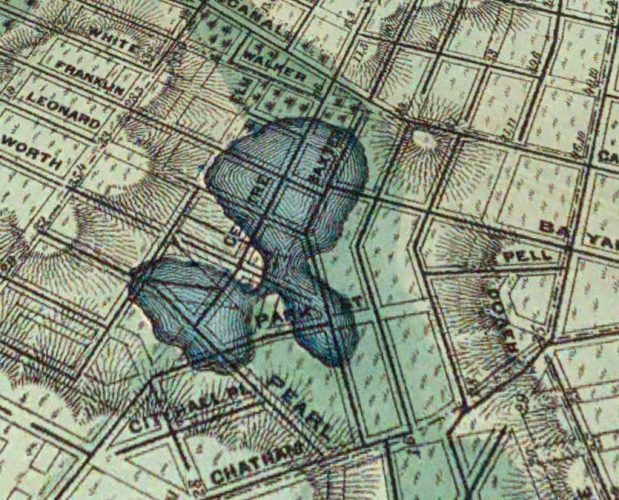Gangs of New York (19th Century)

“Poverty, wretchedness, and vice are rife enough where we are going now” wrote Charles Dickens in his book American Notes. 1 The now orderly streets of Lower Manhattan were once at the mercy of the multiple gangs that dominated in the 19th century. Some of the most prominent and powerful gangs were the rivals, the Dead Rabbits and the Bowery Boys, whose skirmishes scattered from what is now Chinatown to the Civil Center. The Dead Rabbits hailed from Five Points, an area home to mostly Irish and German immigrants, as well as African Americans. The Dead Rabbits was made up mostly of young Irish men. Other Five Points gangs that would often join them in their fights against their enemies were the Plug Uglies, the Shirt Tails and the Chichesters.2 Their rival gang, the Bowery Boys were made up of volunteer firemen and were not immigrants. Under the Bowery Boys, who are named for the area they are from, gangs called “True Blue Americans, the American Guards, the O’Connell Guards, and the Atlantic Guards” gathered together. 3 The names of the Bowery gangs with terms referencing “America” and “guards” implicates a greater meaning behind these gangs and their fights.
Although the members of the gangs were often youths, these actions of these gangs of New York had greater effect than just the areas they lived in. These gangs were influenced and used by the politics of New York at the time. In the mid-19th century, the New York City was continuously receiving a steady flow of immigrants, especially from Ireland and Germany. As predominately Catholic immigrants, entering into a Protestant area brought animosity amongst the people, especially among the working class who were already struggling to survive. As a gang made up Irish immigrants, the Dead Rabbits, like other Irish immigrants in Five Points, supported and were supported by the political machine of Tammany Hall. A Democratic political organization, Tammany Hall catered to the immigrant vote by standing up for their rights and defending them against the nativist feeling at the time. On the opposite of the political spectrum was The Bowery Boys, who were founded by William “Bill the Butcher” Poole, and were a strongly anti-Catholic, anti-Irish, and nativist group. The opposing ideologies of the Bowery Boys and the Dead Rabbits manifested itself in fights and riots throughout the mid-19th century, making one of the biggest riots of the time, until the Draft Riots in 1863.
[1] Charles Dickens, American Notes for General Circulation, http://www.gutenberg.org/files/675/675-h/675-h.htm.
[2] Rebecca Yamin, “Lurid Tales and Homely Stories of New York’s Notorious Five Points,” Historical Archaeology, vol 32, no 1 (1998), 74-85, jstor.org/stable/25616592.
[3] Ibid.
“Bayard is a hard street to travel”
The Fourth of July Riots made such an impact on the city, bands such as the Saugerties band from Hoboken, wrote a song detailing the fight, referencing the “Bloody Sixth Ward.” The extent to which gang life was part of the culture of New York City is evident in the fact that their exploits made ...
“No More Rioting”
The end of the Fourth of July riots came as a relief not only for the people who were afraid to leave their homes, but also for Mayor Wood. The last day of the riots was described in a front page spread by the New York Times: “At 7 o’clock a party came down from the grocery, ...
Annotated Bibliography
Annotated Bibliography Dickens, Charles. “American Notes for General Circulation …” Gutenberg Project. Accessed November 7, 2016. http://www.gutenberg.org/zipcat2.php/675/675-h/675-h.htm. This is a book written by Charles Dickens in the mid-19th century which details his experiences and observations on his trip to America. He wrote about Five Points extensively, and I will use his observations ...
Bowery Boys and Dead Rabbits
On the night of July 4th, 1857 tensions between the Bowery Boys and Dead Rabbits culminated in a bang, starting a two day long riot that would captive the city. The New York Times described the scene: “a crowd of young vagabonds from Cow Bay and the neighborhood proceeded to the Bowery, at Nos. 40 ...
Five Points – Paradise Square
“All that is loathsome, dropping and decayed is here” is the description Charles Dickens wrote in 1842 about Five Points. As you walk in the Civil Center of New York City today, you are surrounded by giant Classical structures, whose pillars and steps lead into court rooms of New York City. Further north is Columbus ...
Morrisey and Poole
John Morrissey and William “Bill the Butcher” Poole were the heads of their respective gangs, the Dead Rabbits and the Bowery Boys. Morrissey, an Irishman, was affiliated with Tammany Hall while Poole was an enforcer for the Know-Nothing party, a nativist organization that was against the influx of Catholic immigrants. Their rivalry came to a ...
The Tombs
Out of all the rioting, the police were noted to “having made only two prisoners whom they carried to the Tombs.” The Tombs is the nickname for City Prison, and was named after its architecture which is based off an Egyptian mausoleum. It lies on top of what was Collect Pond, and extended between Franklin, Leonard ...